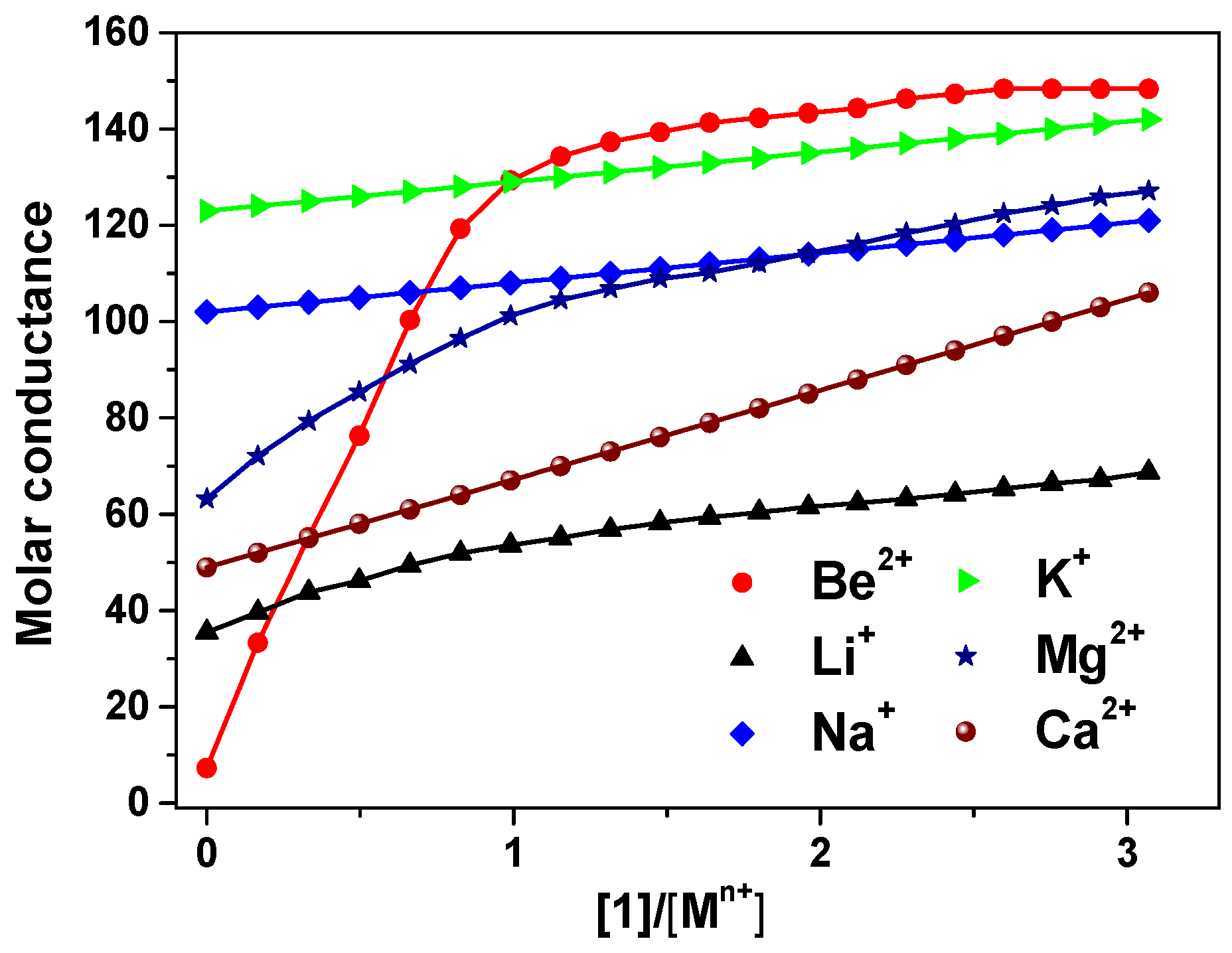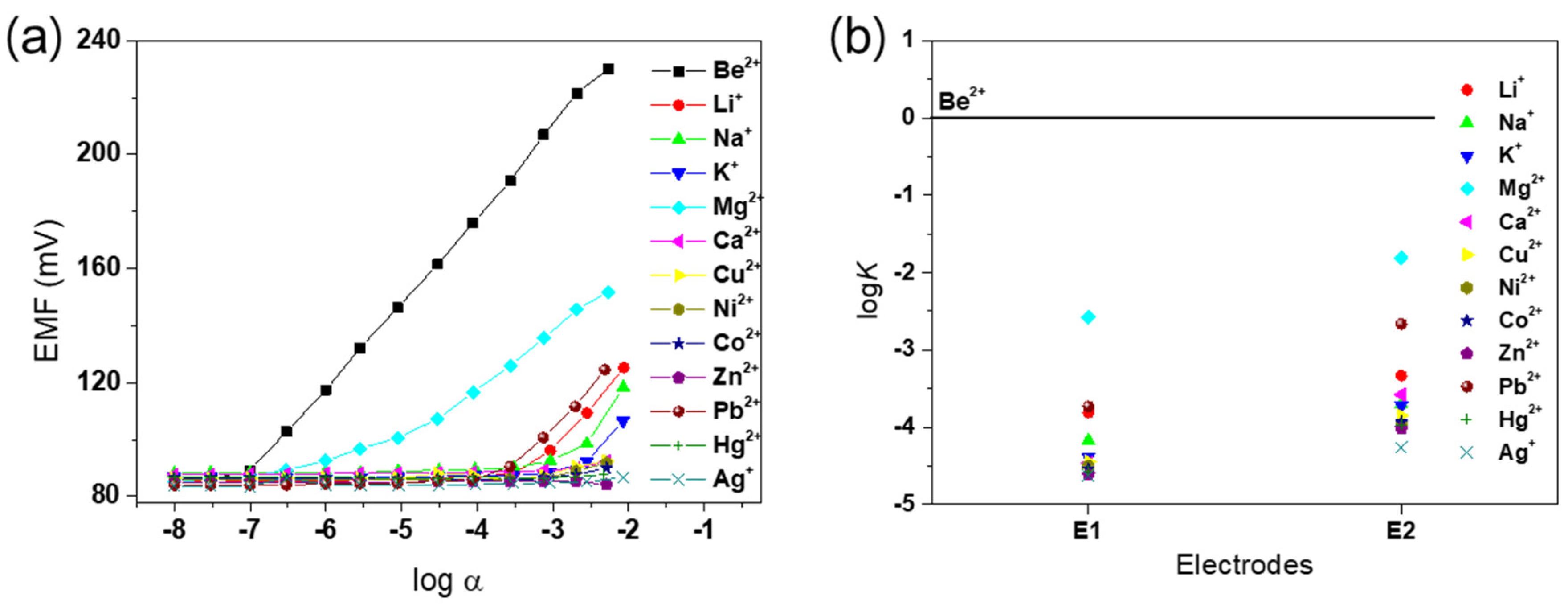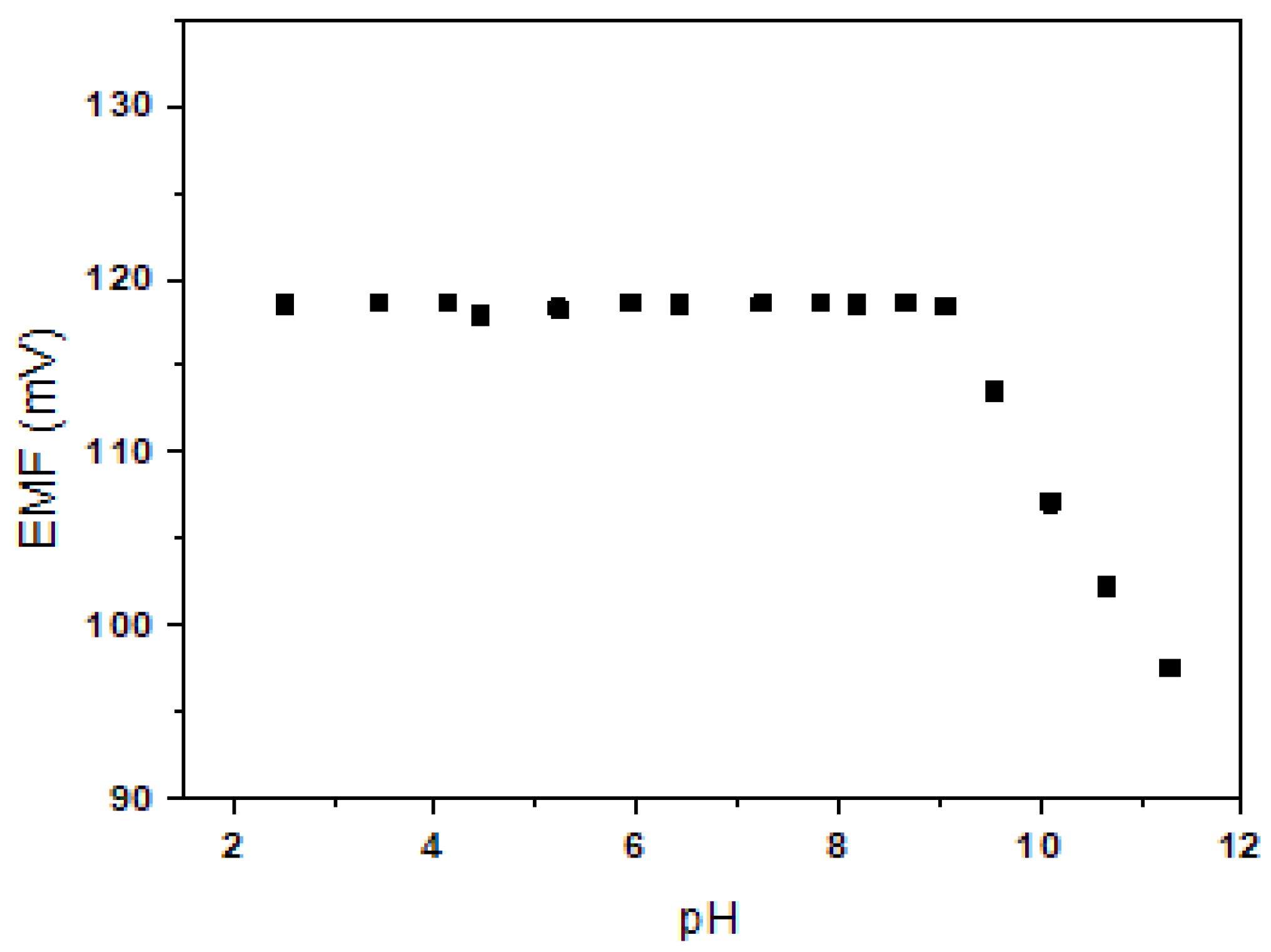Beryllium-Ion-Selective PEDOT Solid Contact Electrode Based on 9,10-Dinitrobenzo-9-Crown-3-Ether
Abstract
:1. Introduction
2. Materials and Methods
2.1. Reagents and Preparation of Solution
2.2. Instrumentation
2.3. Synthesis of the Ionophore
2.4. Conductance Measurements
2.5. Electrode Preparation and ISE Measurements
2.6. Chronopotentiometry Measurement
2.7. Impedance Measurements
3. Results and Discussion
3.1. Binding Studies
3.2. Response and Selectivity of All-Solid-State Be2+-ISE
3.3. pH Effects
3.4. Analytical Applications
4. Conclusions
Supplementary Materials
Author Contributions
Funding
Conflicts of Interest
References
- Gnanakaran, S.G.; Scott, B.; McCleskey, T.M.; García, A.E. Perturbation of Local Solvent Structure by a Small Dication: A Theoretical Study on Structural, Vibrational, and Reactive Properties of Beryllium Ion in Water. J. Phys. Chem. B 2008, 112, 2958–2963. [Google Scholar] [CrossRef]
- Walsh, K.A.; Kaczynski, D.J.; Jacobson, L.A.; Foley, J.; Dorn, C.; London, G.; Hanrahan, R.; Hashiguchi, D.H.; Floyd, D.; Patterson, R.A.; et al. Beryllium Chemistry and Processing; ASM International: Novelty, OH, USA, 2009. [Google Scholar]
- Shao, Y.; Ying, Y.; Ping, J. Recent Advances in Solid-Contact Ion-Selective Electrodes: Functional Materials, Transduction Mechanisms, and Development Trends. Chem. Soc. Rev. 2020, 49, 4405–4465. [Google Scholar] [CrossRef] [PubMed]
- Soleymanpour, A.; Rad, N.A.; Niknam, K. New Diamino Compound as Neutral Ionophore for Highly Selective and Sensitive PVC Membrane Electrode for Be2+ Ion. Sens. Actuators B Chem. 2006, 114, 740–746. [Google Scholar] [CrossRef]
- Ganjali, M.R.; Rahimi-Nasrabadi, M.; Maddah, B.; Moghimi, A.; Faal-Rastegar, M.; Borhany, S.; Namazian, M. Sub-Micro Level Monitoring of Beryllium Ions with a Novel Beryllium Sensor Based on 2, 6-diphenyl-4-benzo-9-crown-3-pyridine. Talanta 2004, 63, 899. [Google Scholar] [CrossRef] [PubMed]
- Gupta, V.; Singh, A.K.; Mergu, N. A New Beryllium Ion-Selective Membrane Electrode Based on Dibenzo(Perhydrotriazino)Aza-14-Crown-4 Ether. Anal. Chim. Acta 2012, 749, 44–50. [Google Scholar] [CrossRef]
- Chumbimuni-Torres, K.Y.; Rubinova, N.; Radu, A.; Kubota, L.T.; Bakker, E. Solid Contact Potentiometric Sensors for Trace Level Measurements. Anal. Chem. 2006, 78, 1318–1322. [Google Scholar] [CrossRef] [PubMed] [Green Version]
- Michalska, A. Optimizing the Analytical Performance and Construction of Ion-Selective Electrodes with Conducting Polymer-Based Ion-to-Electron Transducers. Anal. Bioanal. Chem. 2005, 384, 391–406. [Google Scholar] [CrossRef]
- Michalska, A. All-Solid-State Ion Selective and All-Solid-State Reference Electrodes. Electroanalysis 2012, 24, 1253. [Google Scholar] [CrossRef]
- Buck, R.P. Ion Selective Electrodes in Analytical Chemistry; Freiser, H., Ed.; Plenum Press: New York, NY, USA, 1980; Volume 1, p. 58. [Google Scholar]
- Bobacka, J. Potential Stability of All-Solid-State Ion-Selective Electrodes Using Conducting Polymers as Ion-to-Electron Transducers. Anal. Chem. 1999, 71, 4932–4937. [Google Scholar] [CrossRef] [PubMed]
- Michalska, A.; Maksymiuk, K. Conducting Polymer Membranes for Low Activity Potentiometric Ion Sensing. Talanta 2004, 63, 109–117. [Google Scholar] [CrossRef]
- Veder, J.-P.; De Marco, R.; Clarke, G.; Jiang, S.P.; Prince, K.; Pretsch, E.; Bakker, E. Water Uptake in the Hydrophilic Poly(3,4-Ethylenedioxythiophene):Poly(Styrene Sulfonate) Solid-Contact of All-Solid-State Polymeric Ion-Selective Electrodes. Analyst 2011, 136, 3252–3258. [Google Scholar] [CrossRef]
- Fibbioli, M.; Bandyopadhyay, K.; Liu, S.-G.; Echegoyen, L.; Enger, O.; Diederich, F.; Gingery, D.; Bühlmann, P.; Persson, H.; Suter, A.U.W.; et al. Redox-Active Self-Assembled Monolayers for Solid-Contact Polymeric Membrane Ion-Selective Electrodes. Chem. Mater. 2002, 14, 1721–1729. [Google Scholar] [CrossRef]
- Hassan, S.S.M.; Eldin, A.G.; Amr, A.E.-G.E.; Al-Omar, M.A.; Kamel, A.H.; Khalifa, N.M. Improved Solid-Contact Nitrate Ion Selective Electrodes Based on Multi-Walled Carbon Nanotubes (MWCNTs) as an Ion-to-Electron Transducer. Sensors 2019, 19, 3891. [Google Scholar] [CrossRef] [Green Version]
- Mousavi, Z.; Han, T.; Kvarnström, C.; Bobacka, J.; Ivaska, A. All-solid-state Potassium Ion-selective Electrode with Conducting Polymer Doped with Carbon Nanotubes and C60 as the Ion-to-Electron Transducing Layers. ECS Trans. 2009. [Google Scholar] [CrossRef]
- Ping, J.; Wang, Y.; Wu, J.; Ying, Y. Development of an All-Solid-State Potassium Ion-Selective Electrode Using Graphene as the Solid-Contact Transducer. Electrochem. Commun. 2011, 13, 1529–1532. [Google Scholar] [CrossRef]
- Bobacka, J.; Ivaska, A.; Lewenstam, A. Potentiometric Ion Sensors Based on Conducting Polymers. Electroanalysis 2003, 15, 366. [Google Scholar] [CrossRef]
- Lindfors, T.; Sjöberg, P.; Bobacka, J.; Lewenstam, A.; Ivaska, A. Characterization of a Single-Piece All-Solid-State Lithium-Selective Electrode Based on Soluble Conducting Polyaniline. Anal. Chim. Acta 1999, 385, 163–173. [Google Scholar] [CrossRef]
- Mousavi, Z.; Bobacka, J.; Lewenstam, A.; Ivaska, A. Response Mechanism of Potentiometric AG+ Sensor Based on Poly(3,4-Ethylenedioxythiophene) Doped with Silver Hexabromocarborane. J. Electroanal. Chem. 2006, 593, 219–226. [Google Scholar] [CrossRef]
- Si, P.; Chi, Q.; Li, Z.; Ulstrup, J.; Møller, P.J.; Mortensen, J. Functional Polythiophene Nanoparticles: Size-Controlled Electropolymerization and Ion Selective Response. J. Am. Chem. Soc. 2007, 129, 3888–3896. [Google Scholar] [CrossRef] [PubMed]
- Sari, B.; Talu, M.; Yildirim, F. Electrochemical Polymerization of Aniline at Low Supporting-Electrolyte Concentrations and Characterization of Obtained Films. Russ. J. Electrochem. 2002, 38, 707–713. [Google Scholar] [CrossRef]
- Seol, H.; Kang, D.M.; Shin, S.C.; Shim, Y.-B. Electrochemical Synthesis and Characterization of Poly[3′-(4-Formyl-3-Hydroxyphenyl)-5,2′:5′,2″-Terthiophene] Film. Synth. Met. 2006, 156, 65. [Google Scholar] [CrossRef]
- Cadogan, A.; Lewenstam, A.; Ivaska, A. Anionic Responses of Electrochemically Synthesized Polypyrrole Films. Talanta 1992, 39, 617–620. [Google Scholar] [CrossRef]
- Bobacka, J.; Lewenstam, A.; Ivaska, A. Potentiometric Response of Poly(3-Octylthiophene), Poly(3-Methylthiophene) and Polythiophene in Aqueous Solutions. Talanta 1993, 40, 1437–1444. [Google Scholar] [CrossRef]
- Bobacka, J. Conducting Polymer-Based Solid-State Ion-Selective Electrodes. Electroanalysis 2006, 18, 7–18. [Google Scholar] [CrossRef]
- Sjöberg-Eerola, P.; Bobacka, J.; Sokalski, T.; Mieczkowski, J.; Ivaska, A.; Lewenstam, A. All-Solid-State Chloride Sensors with Poly(3-Octylthiopene) Matrix and Trihexadecylmethylammonium Chlorides as an Ion Exchanger Salt. Electroanalysis 2004, 16, 379–385. [Google Scholar] [CrossRef]
- Prakash, R.; Srivastava, R.; Pandey, P. Copper(II) Ion Sensor Based on Electropolymerized Undoped Conducting Polymers. J. Solid State Electrochem. 2002, 6, 203–208. [Google Scholar] [CrossRef]
- Buchanan, G.W.; Driega, A.B.; Moghimi, A.; Bensimon, C. Electronic Effects on Crown Ether Conformation. X-ray Crystal Structure and 13C NMR Study in Solution and the Solid Phase of 4-Nitrobenzo-9-Crown-3 Ether. Can. J. Chem. 1994, 72, 1764–1768. [Google Scholar] [CrossRef]
- Dye, J.L.; Nicely, V.A. A General Purpose Curve Fitting Program for Class and Research Use. J. Chem. Educ. 1971, 48, 443. [Google Scholar] [CrossRef]
- Pechhold, W.; Liska, E.; Grossmann, H.P.; Hagele, P.C. Recommendations for Nomenclature of Ion-Selective Electrodes. Pure Appl. Chem. 1976, 48, 127. [Google Scholar] [CrossRef]
- Umezawa, Y.; Sato, H. Selectivity Coefficients for Ion-Selective Electrodes: Recommended Methods for Reporting KA,Bpot Values (Technical Report). Pure Appl. Chem. 1995, 67, 507–518. [Google Scholar] [CrossRef]
- De, S.; Boda, A.; Ali, S.M. Preferential Interaction of Charged Alkali Metal Ions (Guest) Within a Narrow Cavity of Cyclic Crown Ethers (Neutral Host): A Quantum Chemical Investigation. J. Mol. Struct. THEOCHEM 2010, 941, 90–101. [Google Scholar] [CrossRef]
- Peng, R.-P.; Chen, B.; Ji, H.-F.; Wu, L.-Z.; Tung, C.-H. Highly Sensitive and Selective Detection of Beryllium Ions Using a Microcantilever Modified with Benzo-9-Crown-3 Doped Hydrogel. Analyst 2012, 137, 1220–1224. [Google Scholar] [CrossRef] [PubMed]




| Li+ | Na+ | K+ | Be2+ | Mg2+ | Ca2+ | |
|---|---|---|---|---|---|---|
| 1 | 4.05 | 3.05 | 2.88 | 6.54 | 4.51 | 3.45 |
Publisher’s Note: MDPI stays neutral with regard to jurisdictional claims in published maps and institutional affiliations. |
© 2020 by the authors. Licensee MDPI, Basel, Switzerland. This article is an open access article distributed under the terms and conditions of the Creative Commons Attribution (CC BY) license (http://creativecommons.org/licenses/by/4.0/).
Share and Cite
Kim, J.; Kim, D.H.; Yang, J.C.; Kim, J.S.; Lee, J.H.; Jung, S.H. Beryllium-Ion-Selective PEDOT Solid Contact Electrode Based on 9,10-Dinitrobenzo-9-Crown-3-Ether. Sensors 2020, 20, 6375. https://doi.org/10.3390/s20216375
Kim J, Kim DH, Yang JC, Kim JS, Lee JH, Jung SH. Beryllium-Ion-Selective PEDOT Solid Contact Electrode Based on 9,10-Dinitrobenzo-9-Crown-3-Ether. Sensors. 2020; 20(21):6375. https://doi.org/10.3390/s20216375
Chicago/Turabian StyleKim, Junghwan, Dae Hee Kim, Jin Cheol Yang, Jae Sang Kim, Ji Ha Lee, and Sung Ho Jung. 2020. "Beryllium-Ion-Selective PEDOT Solid Contact Electrode Based on 9,10-Dinitrobenzo-9-Crown-3-Ether" Sensors 20, no. 21: 6375. https://doi.org/10.3390/s20216375
APA StyleKim, J., Kim, D. H., Yang, J. C., Kim, J. S., Lee, J. H., & Jung, S. H. (2020). Beryllium-Ion-Selective PEDOT Solid Contact Electrode Based on 9,10-Dinitrobenzo-9-Crown-3-Ether. Sensors, 20(21), 6375. https://doi.org/10.3390/s20216375




